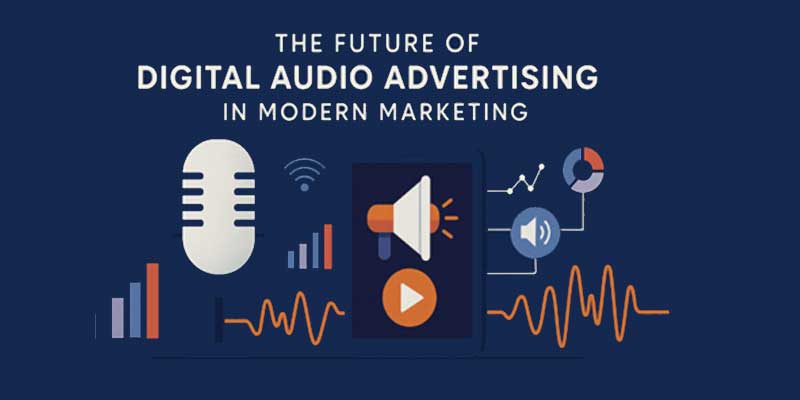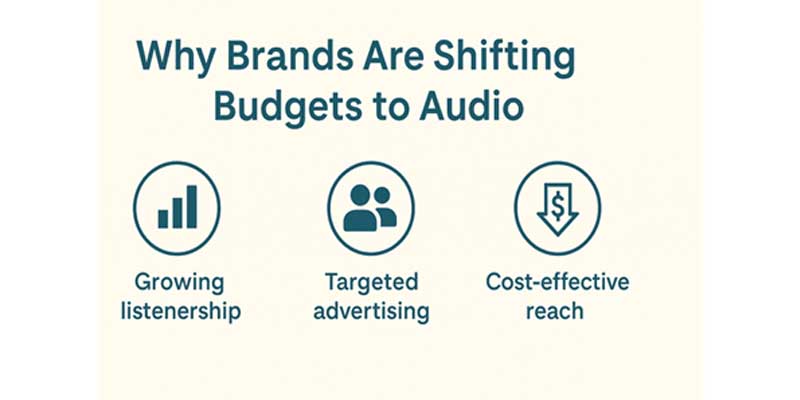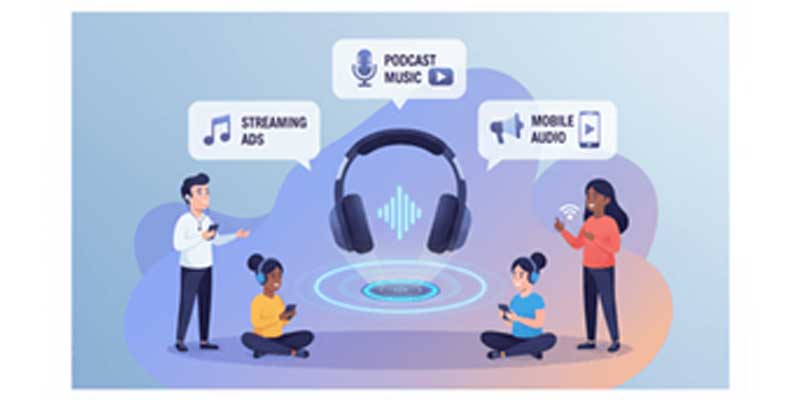

Audio advertising refers to promotional messages delivered through digital audio channels such as music streaming platforms, podcasts, internet radio, and smart speakers. Unlike traditional display or video ads, audio ads rely on sound alone to capture attention and connect with audiences. They typically appear in between songs on platforms like Spotify or Pandora, or as sponsorships and segments in podcasts.
The strength of audio advertising lies in its ability to reach users during moments where visual engagement isn’t possible — for example, while commuting, exercising, or multitasking at home. As a result, it offers brands an opportunity to engage consumers in a highly personal and less intrusive way, embedding messages into daily routines.
For decades, radio served as the primary audio advertising medium, with jingles and sponsorships building brand recall. However, the rise of the internet and mobile devices has transformed how people consume audio. Streaming platforms like Spotify, Apple Music, and regional players such as Gaana and JioSaavn have taken the lead, offering vast libraries of music on-demand.
Podcasts, once a niche format, have now exploded into mainstream media. Global audiences increasingly tune into podcasts across genres — from business to entertainment — creating premium inventory for advertisers. Unlike linear radio, digital platforms allow precise targeting, measurable outcomes, and programmatic buying, making audio a performance-driven channel.
This shift from traditional radio to digital formats reflects consumer demand for personalization and convenience. As listeners migrate online, advertisers follow, seeking to align their messages with the most engaged audiences.

Brands are allocating more of their ad spend toward digital audio for several reasons:
Marketers are also responding to the rise of voice-first devices such as Alexa and Google Home, where audio is the default medium of interaction. In an era where consumer attention is fragmented, audio stands out as a medium that doesn’t compete with screens, making it an essential part of a balanced media mix.
The global digital audio advertising market has been expanding at double-digit growth rates, driven by widespread adoption of streaming services and podcast platforms.
This growth is not only fueled by consumer demand but also by advertiser confidence in measurable ROI. Unlike traditional broadcast radio, digital platforms provide granular insights into impressions, completion rates, and audience demographics. As more brands integrate audio into their omnichannel campaigns, analysts expect audio’s share of total digital ad spend to increase steadily, particularly in sectors like retail, consumer goods, and entertainment.
The streaming era has revolutionized audio consumption, shifting audiences from passive to highly personalized listening experiences. Listeners now curate their own playlists, follow podcasts on niche topics, and subscribe to ad-free or ad-supported tiers depending on preference.
Data shows that younger demographics — particularly Gen Z and millennials — consume over three hours of streaming audio daily, often while multitasking. This trend has unlocked unique advertising windows: during workouts, cooking sessions, or commuting, when screen time is limited.
Importantly, the shift has also blurred the line between music, podcasts, and short-form audio bites. Consumers expect seamless, on-demand access, which in turn requires advertisers to design messages that blend naturally into these personalized experiences without feeling intrusive.
Regional adoption patterns reveal that digital audio advertising is far from uniform. North America and Western Europe remain the most mature markets, with programmatic audio well established. Asia-Pacific is experiencing rapid growth, driven by mobile-first users and the popularity of regional music streaming apps. Meanwhile, Latin America has seen podcast listenership surge, making it a hotspot for sponsorship opportunities.
Audience segmentation is another key driver of success. Urban professionals, for example, often engage with podcasts during commutes, while younger listeners are more responsive to music-streaming ads delivered via mobile. Regional languages and cultural preferences also play a major role in campaign effectiveness. Brands tailoring their audio strategies to these unique audience segments consistently achieve stronger engagement and higher return on investment.

Streaming platforms like Spotify, Apple Music, and JioSaavn dominate the digital audio space. These services run ads in between songs or as sponsored playlists, offering brands access to millions of daily listeners. Streaming ads can be targeted by age, location, device, or even listening mood, making them highly contextual.
What sets them apart is the ability to reach audiences in moments where visual media can’t compete — during workouts, driving, or studying. With formats ranging from 15-second interstitials to sponsored sessions that unlock ad-free listening, streaming platforms give marketers both flexibility and scale. The seamless integration of ads into a music environment helps reinforce brand messaging without disrupting the overall user experience.
Podcasts have become a mainstream content format, offering advertisers access to highly engaged, niche audiences. Unlike streaming music, podcasts create deeper listener loyalty, as audiences often trust the hosts they follow. This has given rise to host-read ads, where the presenter personally delivers the brand’s message, blending it with the content in a conversational tone.
Host-read ads are particularly effective because they feel authentic, driving stronger recall and conversions compared to pre-recorded spots. Sponsorship formats also allow brands to support entire series or episodes, building long-term association with a particular subject area or community. From tech enthusiasts to lifestyle audiences, podcasts offer unparalleled targeting precision for advertisers looking to align with specific interests.
Programmatic audio advertising uses automated technology to buy and place ads in real time, similar to display or video. This format enables advertisers to deliver highly personalized messages based on listener behavior, demographics, and device data. For instance, a food delivery app can run localized audio ads at dinner time, dynamically inserting offers tailored to each region.
The advantage of programmatic audio is scalability. It allows campaigns to run across multiple streaming platforms and internet radio services simultaneously, with central management of bids and budgets. Real-time reporting ensures marketers can optimize campaigns on the fly. With the growing availability of first- and second-party data, programmatic audio is fast becoming the backbone of digital audio ad strategies worldwide.
Smart speakers like Amazon Echo and Google Home, along with voice assistants such as Siri, have opened new frontiers in digital audio advertising. These devices are now embedded in households globally, creating opportunities for interactive, voice-activated ad experiences.
Brands can engage listeners through call-and-response formats, where users ask for product details, coupons, or nearby store locations directly through their device. This type of interaction goes beyond awareness, driving measurable engagement and purchase intent. For example, a food brand can prompt users to “add ingredients to shopping list” via a smart speaker command.
As the ecosystem of connected devices grows, smart speaker advertising is expected to become a central channel for brands, especially in markets with high adoption of voice technology.
One of the strongest advantages of digital audio advertising is its ability to deliver personalized, context-aware messages. Platforms collect insights on user behavior such as playlists, podcasts followed, or even time of day when a listener tunes in. This allows advertisers to serve ads that align with moods and activities — for instance, promoting an energy drink during workout playlists or a meditation app within wellness podcasts.
Unlike traditional radio, digital audio is not a one-size-fits-all channel. Advanced targeting options, including demographics, geolocation, and behavioral patterns, ensure that messages are delivered to the right people at the right time. This level of precision improves ad relevance and reduces wastage, helping brands maximize returns while enhancing the listener experience.
Audio advertising is uniquely positioned to achieve high engagement and strong recall rates. Research indicates that listeners retain brand messages better in audio formats compared to text or banner ads, largely because audio occupies a personal, distraction-free space. When people listen to podcasts or music, they often do so with earphones or in-car systems, which creates a more intimate environment for brand storytelling.
Additionally, audio ads often play during multitasking activities like cooking, jogging, or driving, where screen-based ads cannot compete. This hands-free environment ensures that audio messaging is less likely to be ignored or skipped. The immersive nature of sound — supported by elements like tone, rhythm, and emotion — makes audio ads not only memorable but also effective in shaping consumer perception.
For many brands, especially those with limited budgets, audio advertising represents a cost-efficient alternative to video. Producing a high-quality video ad often requires significant investment in scripting, filming, editing, and post-production. By contrast, creating an impactful audio ad requires fewer resources, often limited to voice talent, music beds, and sound design.
Distribution costs are also lower. Streaming services and podcast platforms offer scalable pricing models, making audio accessible to both large corporations and smaller businesses. Importantly, audio still delivers measurable performance through metrics like impressions, completion rates, and brand lift studies. For brands seeking to balance impact with affordability, digital audio ads serve as an ideal middle ground in the marketing mix.
While digital audio platforms provide more insights than traditional radio, advertisers still face challenges in accurately measuring ROI. Metrics such as impressions, completion rates, and reach are common, but they don’t always capture the full impact of an audio campaign. For instance, brand lift or influence on offline purchases can be difficult to track.
Attribution is particularly complex in multitasking scenarios. A listener may hear an audio ad while driving and later make a purchase on their mobile, leaving the path of influence underreported. Although advancements in pixel tracking and cross-device measurement are improving accuracy, the lack of standardized industry benchmarks remains a barrier. Brands must often rely on blended models — combining surveys, brand recall studies, and digital analytics — to gauge effectiveness.
Another challenge is the risk of listener fatigue. As more platforms monetize through ads, audiences are exposed to repeated interruptions, which can cause irritation and disengagement. Unlike video, where visuals help sustain attention, audio relies entirely on sound, making poorly designed or repetitive ads more noticeable.
Ad skipping is also an issue on certain platforms, particularly those that offer premium, ad-free subscriptions. As consumers grow accustomed to on-demand, interruption-free experiences, they are less tolerant of intrusive ad formats. The solution lies in creative innovation: shorter, contextually relevant ads and sponsorship models that integrate more naturally with content. However, balancing ad load with user experience remains a delicate task for both platforms and advertisers.
As with all forms of digital advertising, privacy and data regulation are growing concerns in audio. Platforms rely heavily on listener data for targeting, including location, listening behavior, and device usage. With regulations like GDPR and CCPA tightening data privacy requirements, advertisers must tread carefully to ensure compliance.
The growing use of smart speakers and voice assistants also introduces new risks. Voice data, if mishandled, can raise concerns about surveillance and consumer trust. For brands, this means adopting transparent practices and ensuring data is anonymized, consent-based, and securely managed. Advertisers that fail to address privacy concerns risk both reputational damage and regulatory penalties.
Programmatic technology has transformed audio advertising by automating the buying and placement of ad inventory. Instead of relying on manual deals, advertisers now use real-time bidding (RTB) to secure ad slots across multiple streaming platforms and internet radio networks. This allows brands to scale campaigns while maintaining efficiency and precision.
Programmatic systems also enable real-time optimization. Campaigns can be adjusted on the fly based on listener engagement, device type, or contextual triggers like time of day. For example, a ride-sharing app can automatically run ads during peak commute hours, while a coffee brand may push offers in the morning. This flexibility not only maximizes relevance but also reduces wasted ad spend, making programmatic audio the backbone of performance-driven campaigns.
Artificial intelligence is playing an increasingly central role in the evolution of audio advertising. By analyzing massive datasets on listener habits, AI helps advertisers create personalized, context-specific audio messages. These can include tailored product recommendations, dynamic ad insertions, or even variations in tone and delivery depending on audience segments.
In 2025, advancements in voice cloning and generative AI are making personalization even more sophisticated. Brands can now deploy hyper-targeted ads where the same campaign adapts seamlessly for different listener profiles — for example, using different voices, dialects, or offers for urban millennials versus suburban families. AI also powers predictive modeling, helping marketers anticipate what listeners want next, further increasing engagement and conversion potential.
One of the most exciting innovations in digital audio is the rise of interactive and shoppable ad formats. These ads allow listeners to engage with content in real time, bridging the gap between brand awareness and direct action. For instance, a listener might hear an ad for a fashion retailer and respond with a voice command to receive a discount code via SMS.
Shoppable audio campaigns are particularly impactful when paired with smart speakers or mobile devices, where interactions can lead directly to purchases. They also encourage higher engagement by transforming ads from passive experiences into active conversations. As e-commerce and audio converge, interactive formats are expected to redefine how consumers shop, creating frictionless pathways from listening to buying.

The foundation of an effective audio campaign lies in scriptwriting. Messages should be concise, conversational, and aligned with the listening context. Strong voiceovers, background music, and clear calls to action ensure ads stand out without overwhelming the listener. Brands that adapt tone to the mood of the platform — upbeat for workout playlists, calm for wellness podcasts — achieve stronger engagement.
Success in audio advertising depends on reaching the right listener at the right moment. Platforms allow precise targeting by age, location, interests, and device type. Strategic placement, such as mid-roll podcast ads or morning commute slots, maximizes relevance. Marketers who match ad delivery with user intent — like promoting food delivery during dinner hours — often see higher response rates.
A winning strategy balances cost allocation and integration with other media channels. Budgets should factor in creative production, programmatic bidding, and testing multiple formats. Pairing audio with video, display, or social ads creates consistent cross-channel reinforcement. For example, running a podcast sponsorship alongside retargeting banners amplifies brand recall and drives conversions more effectively than standalone campaigns.
Advertisers commonly track impressions, completion rates, and frequency to measure reach and engagement. Brand lift studies and recall surveys provide insights into how effectively the message resonates with listeners beyond surface-level exposure.
Cross-device behavior makes attribution complex. Brands increasingly use multi-touch attribution and pixel-based tracking to link audio impressions to downstream actions. Surveys combined with analytics help validate campaign ROI more accurately.
While video offers richer storytelling, audio delivers lower costs and higher recall per dollar spent. Compared to display, audio is less skippable and often integrated seamlessly into daily routines, giving it a unique advantage in brand reinforcement.
Spotify has pioneered innovative ad formats like Sponsored Sessions and Playlist Sponsorships, allowing brands to exchange ad-free listening for user engagement. Campaigns in the FMCG sector have shown strong results, with recall rates significantly higher than banner ads. The platform’s precise targeting and mood-based placements make it a favorite for performance-driven brands.
Podcast sponsorships continue to deliver exceptional returns. Brands partnering with hosts in lifestyle, business, or wellness niches often benefit from the authenticity and trust audiences place in presenters. For example, a financial services brand sponsoring a personal finance podcast recorded higher conversion rates compared to traditional display campaigns, demonstrating the persuasive power of host-read ads.
Interactive audio ads have proven effective in creating direct consumer actions. In one campaign, a beverage company enabled listeners to claim discount coupons via voice command through smart speakers. Engagement rates exceeded expectations, proving that conversational and shoppable formats can move listeners from awareness to action without leaving the audio environment.
Advances in AI are enabling synthetic voice ads that can adapt tone, language, and even dialect to match listener profiles. This flexibility offers scalable personalization, though ethical use and authenticity remain key considerations.
As AR and VR adoption grows, audio will play a central role in immersive brand storytelling. Layered soundscapes and interactive voice ads will enhance engagement, bridging real-world experiences with digital campaigns.
Audio is increasingly integrated with search, display, and social campaigns, reinforcing consistent brand presence. Linking audio strategies with proven frameworks like this search engine optimization checklist ensures measurable growth across touchpoints.
Audio ads have become a popular trend in the recent past. Hence, focusing on digital audio ads can be a great idea for brands that want to build brand awareness and grow their brand awareness and grow their brand. Bud, with the help of its creative team, can help you create audio ads that are captivating and engaging. Creating persuasive content can help you grow and get maximum brand awareness. As an expert PPC company in Bangalore and as a well-known digital marketing agency in Bangalore, Bud can help you place your audio ads at the right place where you can reach your targeted audiences.